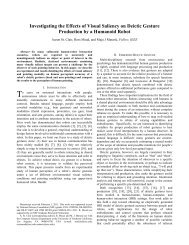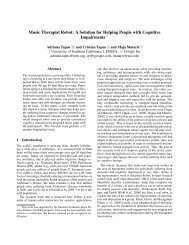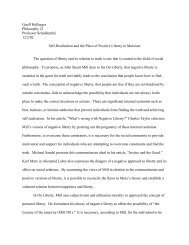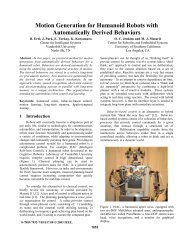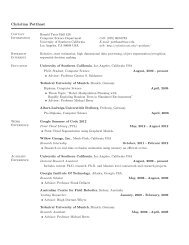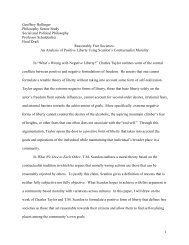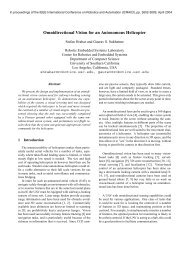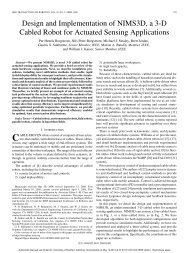Fasola & Matarić. A SAR <strong>Exercise</strong> <strong>Coach</strong> <strong>for</strong> <strong>the</strong> <strong>Elderly</strong>rating scale, <strong>the</strong> intelligence of <strong>the</strong> robot was measured according to <strong>the</strong> following fouradjectives: competent, clever, intelligent, and smart (Cronbach’s α = .93).To help capture <strong>the</strong> robot’s social attributes, we measured both <strong>the</strong> social attractiontowards <strong>the</strong> robot and <strong>the</strong> social presence of <strong>the</strong> robot. Social attraction was measured bya modified version of <strong>the</strong> Interpersonal Attraction Scale of McCroskey and McCain(1974). Participants reported <strong>the</strong>ir level of agreement with <strong>the</strong> following four statements:I think Bandit could be a friend of mine; I think I could spend a good time with Bandit; Icould establish a personal relationship with Bandit; I would like to spend more time withBandit (Cronbach’s α = .88). The statements were rated on a 7-point scale anchored by“Very Strongly Disagree” (1) and “Very Strongly Agree” (7). Social presence wasmeasured by a 10-point scale anchored by “Not at all” (1) and “Very much” (10) withquestions from Jung and Lee (2004) such as <strong>the</strong> following: While you were exercisingwith Bandit, how much did you feel as if you were interacting with an intelligent being?(Cronbach’s α = .87).To assess perceptions of <strong>the</strong> exercise capabilities of <strong>the</strong> system, we measuredparticipant evaluations of <strong>the</strong> robot as an exercise partner. Four items were used, eachmeasured according to a 10-point scale anchored by “Not at all” (1) and “Very much”(10): How much did you enjoy exercising with Bandit?; How likely would you be torecommend Bandit as an exercise partner to your friends?; How much would you like toexercise with Bandit in <strong>the</strong> future?; How much have you been motivated to exercisewhile interacting with Bandit? (Cronbach’s α = .93).4.3.3 User Per<strong>for</strong>mance MeasuresTo help assess <strong>the</strong> effectiveness of <strong>the</strong> SAR exercise system in motivating exerciseamong <strong>the</strong> participants, we collected fifteen different objective measures during <strong>the</strong>exercise sessions regarding user per<strong>for</strong>mance and compliance in <strong>the</strong> exercise task.Five per<strong>for</strong>mance measures were captured during user interaction in <strong>the</strong> Workoutgame, including <strong>the</strong> average time to gesture completion (from <strong>the</strong> moment <strong>the</strong> robotdemonstrates <strong>the</strong> gesture to successful user completion of <strong>the</strong> gesture), number of secondsper exercise completed, number of failed exercises, number of movement prompts by <strong>the</strong>robot to <strong>the</strong> user due to lack of arm movement, and feedback percentage. The feedbackpercentage measure refers to <strong>the</strong> fraction of gestures, out of <strong>the</strong> total given, <strong>for</strong> which <strong>the</strong>robot needed to provide verbal feedback to <strong>the</strong> users regarding <strong>the</strong>ir arm positions inorder to help guide <strong>the</strong>m to correct gesture completion.For <strong>the</strong> Sequence game, we captured four objective measures: <strong>the</strong> average time togesture completion, average number of sequences completed, average number of gesturepairs completed, and <strong>the</strong> feedback percentage. In <strong>the</strong> Memory game, we recorded <strong>the</strong>maximum score over all sessions and all users, average maximum score among individualusers, and average time per gesture attempt. For <strong>the</strong> Imitation game, <strong>the</strong> only measurecaptured was <strong>the</strong> number of movement prompts by <strong>the</strong> robot due to lack of user armmovement.The remaining two measures concerned user activity during <strong>the</strong> entire exercisesession: <strong>the</strong> average total number of exercises completed, and number of breaks taken by<strong>the</strong> user.20
Fasola & Matarić. A SAR <strong>Exercise</strong> <strong>Coach</strong> <strong>for</strong> <strong>the</strong> <strong>Elderly</strong>Table 1. Summary of <strong>the</strong> relations between <strong>the</strong> five design principles and <strong>the</strong>ir relatedstudy measures (evaluation and/or per<strong>for</strong>mance based).Design PrincipleRelated Measures (Survey and/or Per<strong>for</strong>mance)1) Motivating Enjoyableness of interactionAccording to Csikszentmihalyi (1975), intrinsically motivating activitiesare characterized by user enjoyment.2) Fluid andHighly InteractiveAverage time to gesture completion; seconds per exercise; feedbackpercentageThe fluidity and real-time interactive nature of <strong>the</strong> task is mostappropriately illustrated by <strong>the</strong> speed and accuracy of <strong>the</strong> objective userper<strong>for</strong>mance statistics (which are tightly linked to <strong>the</strong> feedback andresponsiveness of <strong>the</strong> robot).3) Personable Helpfulness; companionship; social attraction; social presenceThe robot’s personable qualities, such as expressing empathy, reassurance,praise, reference to past user per<strong>for</strong>mance, continuity between sessions,humor, politeness, and referring to <strong>the</strong> user by name, are best characterizedby <strong>the</strong> perceived helpfulness and companionship of <strong>the</strong> robot.Fur<strong>the</strong>rmore, more general assessments of <strong>the</strong> personable traits of <strong>the</strong> robot(and of <strong>the</strong> robot’s embodiment) are captured by <strong>the</strong> social attraction andsocial presence measures.4) Intelligent Intelligence of <strong>the</strong> robotParticipant evaluations of <strong>the</strong> perceived intelligence of <strong>the</strong> robot provide anappropriate one-to-one assessment of this design principle in practice.5) Task-Driven Value/usefulness of interaction; robot as exercise partner;all user exercise per<strong>for</strong>mance measuresParticipant evaluations of <strong>the</strong> usefulness of <strong>the</strong> interaction, and of <strong>the</strong> robotas an exercise partner, serve to illustrate <strong>the</strong> perceived effectiveness of <strong>the</strong>system in encouraging users to exercise (important <strong>for</strong> establishing usertrust in <strong>the</strong> system). Fur<strong>the</strong>rmore, <strong>the</strong> objective per<strong>for</strong>mance measuresserve to demonstrate <strong>the</strong> actual effectiveness of <strong>the</strong> system in elicitingphysical exercise among <strong>the</strong> users (<strong>the</strong> goal of <strong>the</strong> specific healthcare task).4.3.4 Relation to Design PrinciplesThe survey evaluation measures and <strong>the</strong> user per<strong>for</strong>mance measures toge<strong>the</strong>r serve toevaluate our SAR system approach and design principles. Specifically, participantevaluations of each of <strong>the</strong> five SAR design principles were effectively captured by one ormore of <strong>the</strong> described study measures. Table 1 provides a summary of <strong>the</strong> relationsbetween each of <strong>the</strong> five design principles outlined in Section 3.1 and <strong>the</strong>ir correspondingsurvey and/or objective per<strong>for</strong>mance measures.21



